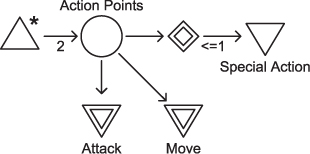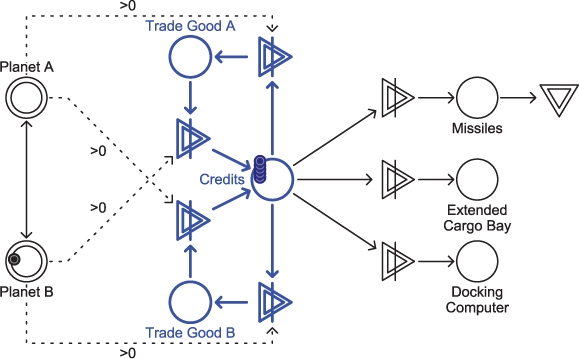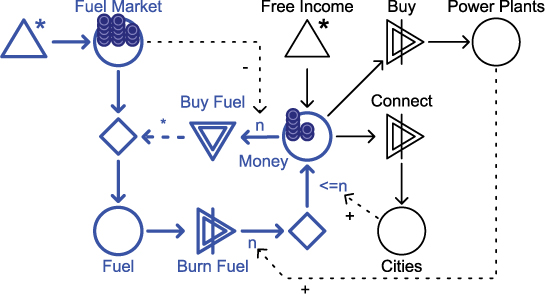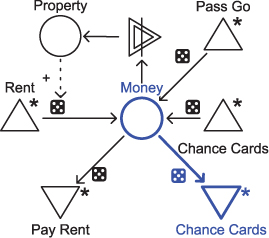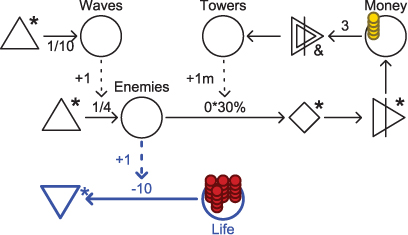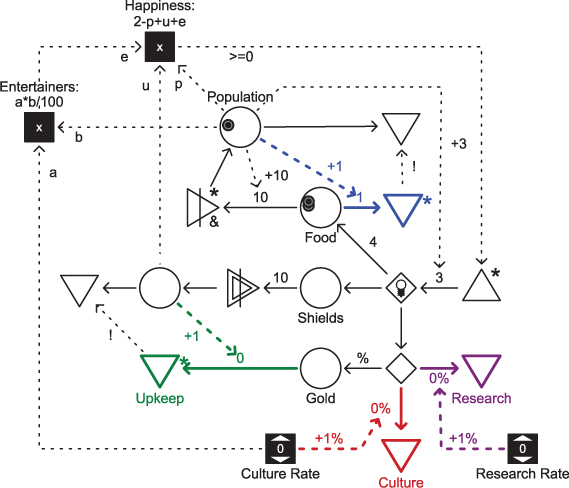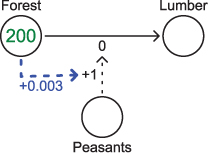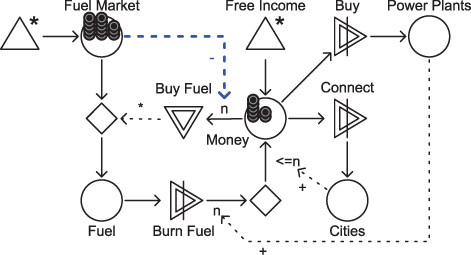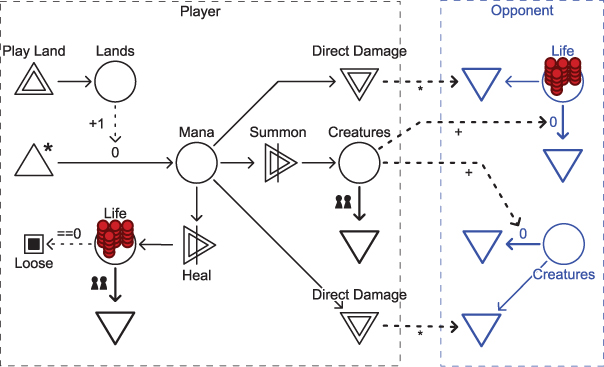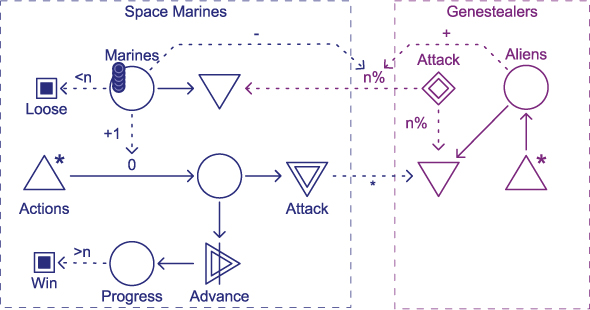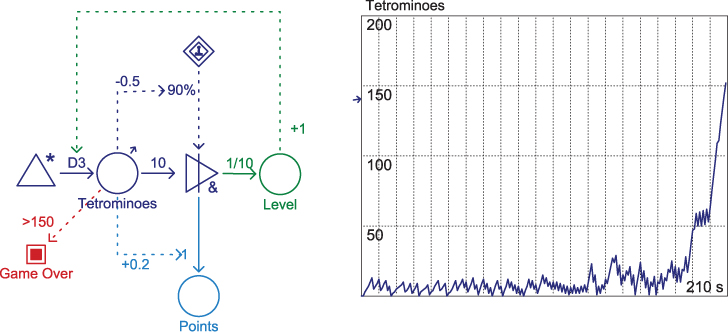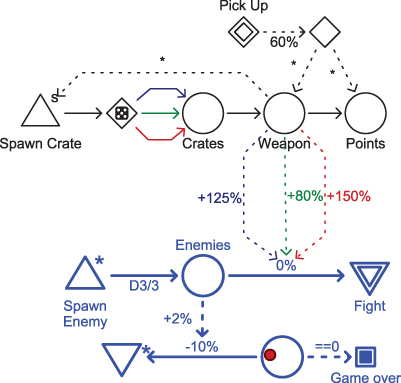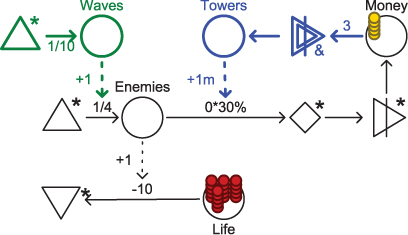Appendix B. Design Pattern Library
Static Engine
• Type: Engine
• Intent: Produces a steady flow of resources over time for players to consume or to collect while playing the game.
• Motivation: A static engine creates a steady flow of resources that never dries up.
Applicability
Use a static engine when:
• You want to limit players’ actions without complicating the design. A static engine forces players to think how they are going to spend their resources without much need for long-term planning.
Structure
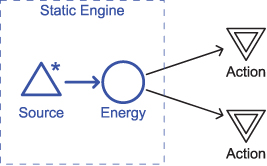
Participants
• Energy that is produced by the static engine
• A source that produces energy
• Actions the player can spend energy on
A static engine must provide players with some options to spend the resources on. A static engine with only one option to spend the resources on is of little use.
Collaborations
The source produces energy at a fixed or an unpredictable rate.
Consequences
The production rate of a static engine does not change, so the effects of the engine on game balance are very predictable. A static engine can be the cause of imbalance only when its production rate is not the same for all the players.
A static engine generally does not inspire long-term strategies: Collecting resources from a static engine, if possible at all, will be quite obvious.
Implementation
Normally, it is simple to implement a static engine: A single source that produces the energy will suffice. It is possible to add multiple steps in the energy production, but in general this will add little to the game.
A static engine can be made unpredictable by using some form of variation in the production rate. An unpredictable static engine will force the player to prepare for periods of fewer resources and reward players who make plans that can withstand bad luck. The easiest way to create an unpredictable static engine is to use randomness to vary the output level of resources or the length of time between moments of production, but skill or multiplayer dynamics could work as well.
The outcome of random production rates can be, but does not need to be, the same for every player. By using an unpredictable static engine that generates the same resources for all players, the luck factor is evened out without affecting the unpredictability. This puts more emphasis on the planning and timing that the pattern introduces. An example would be a game in which all players secretly decide how many resources all players can get. The lowest number will be the number of resources to enter play for everyone, while the players who proposed the lowest can act first. This would automatically set up some feedback from the game’s current state to this mechanism. (This system discourages inflation.)
Examples
The energy produced by the spacecraft in Star Wars: X-Wing Alliance is an example of a static engine. The energy can be diverted to boost the player’s shields, speed, and lasers. This is a vital strategic decision in the game, and the energy allocation can be changed at any moment. The amount of energy generated every second is the same for all spacecraft of the same type (Figure B.1).
Figure B.1. Distribution of energy in Star Wars: X-Wing Alliance
In many turn-based games, the limited number of actions a player can perform in each turn can be considered a static engine. In this case, the focus of the game is the choice of actions, and generally players cannot save actions for later turns. The fantasy board game Descent: Journeys in the Dark uses this mechanism. Players can choose between one of three actions for their hero every turn: move, attack, or prepare a Special Action (Figure B.2). In our diagram, a player gets two actions every turn and can perform the special action only once per turn. This creates five possible combinations: The player can attack twice, move twice, attack and move, attack and do a special action, or move and do a special action.
Figure B.2. Distribution of action points in the board game Descent: Journeys in the Dark
Related Patterns
• A weak static engine can prevent deadlocks in a converter engine.
• A static engine can be elaborated by a dynamic engine, a converter engine, or a slow cycle pattern.
Dynamic Engine
• Type: Engine
• Intent: A source produces an adjustable flow of resources. Players can invest resources to improve the flow.
• Motivation: A dynamic engine produces a steady flow of resources and opens the possibility for long-term investment by allowing the player to spend resources to improve production. The core of a dynamic engine is a positive constructive feedback loop.
Applicability
Use a dynamic engine when you want to introduce a trade-off between long-term investment and short-term gains. This pattern gives the player more control over the production rate than a static engine does.
Structure
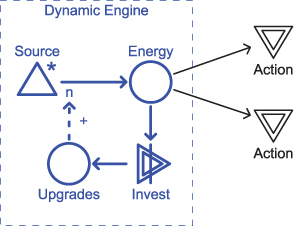
Participants
• Energy produced by the dynamic engine
• A source that produces energy
• Upgrades that affect the production rate of energy
• An invest action that creates upgrades
• Actions the player can spend on, including the invest action
Collaborations
The dynamic engine produces energy that is consumed by a number of actions. One action (Invest) produces upgrades that improve the energy output of the dynamic engine. A dynamic engine allows two different types of upgrades a player can invest in to improve its production:
• The frequency at which energy is produced
• The number of energy tokens generated each time
The differences between the two are subtle. A high frequency will create a steady flow, while a high number (but low frequency) will lead to bursts of energy.
Consequences
A dynamic engine creates a powerful positive constructive feedback loop that probably needs to be balanced by some pattern implementing negative feedback, such as any form of friction. Alternatively, balance it by using escalation to create challenges of increasing difficulty.
When using a dynamic engine, you must be careful not to create a dominant strategy, either by favoring the long-term strategy too much or by making the costs for the long-term strategy too high.
A dynamic engine generates a distinct gameplay signature. A game that consists of little more than a dynamic engine will cause the players to invest at first, appearing to make little progress. Beyond a certain point, the player will start to make more progress and needs to try to do so at the quickest possible pace.
Implementation
The chance of building a dominant strategy that favors either long-term or short-term investment is reduced when some sort of randomness is introduced in the dynamic engine. However, the positive feedback loop that exists in an unpredictable dynamic engine will amplify the luck a player has in the beginning of the game, which might result in too much randomness quickly.
The outcome of random production rates can be, but does not need to be, the same for every player. By using an unpredictable dynamic engine that generates the same resources for all players, the luck factor is reduced without affecting the unpredictability. This puts more emphasis on the player’s chosen strategy.
Some dynamic engines allow the player to convert upgrades back into energy, usually against a lower rate than the original investment. When upgrades are expensive and the player frequently needs large amounts of energy, this becomes a viable option.
Examples
In StarCraft, one of the abilities of Space Construction Vehicle (SCV) units is to harvest minerals that can be spent on creating more SCV units to increase the mineral harvest (Figure B.3). In its essence, this is a dynamic engine that propels the game (although in StarCraft the number of minerals is limited and SCV units can be killed by enemies). It immediately offers the player a long-term option (investing in many SCV units) and a short-term option (investing in military units to attack enemies quickly or respond to immediate threats).
Figure B.3. The harvesting of minerals in StarCraft.
The economy of The Settlers of Catan revolves around a dynamic engine affected by chance. The roll of the dice determines which game board tiles will produce resources at the start of each player’s turn. Building more villages increases the chance to receive resources every turn. The player can also upgrade villages into cities, which doubles the resource output of each tile. The Settlers of Catan gets around the typical signature a dynamic engine creates by allowing different types of invest actions and by measuring upgrades instead of energy to determine the winner. See the section “Producing Progress Indirectly” in Chapter 11, “Progression Mechanisms,” for a more detailed discussion and diagram for The Settlers of Catan.
Related Patterns
• Dynamic friction and attrition are suitable patterns to counter the long-term benefits of a dynamic engine, while static friction emphasizes the long-term investments.
• A dynamic engine elaborates the static engine pattern.
• A dynamic engine can be elaborated by the engine building and the worker placement pattern.
Converter Engine
• Type: Engine
• Intent: Two converters set up in a loop create a surplus of resources that can be used elsewhere in the game.
• Motivation: Two resources that can be converted into each other fuel a feedback loop that produces a surplus of resources. At least one of the converters must output more resources than it takes in to create the surplus. The converter engine is a more complicated mechanism than most other engines but also offers more opportunities to improve the engine. As a result, a converter engine is nearly always dynamic.
Applicability
Use a converter engine when:
• You want to create a more complex mechanism to provide the player with more resources than a static or dynamic engine provides. (Our example converter engine contains two interactive elements, while the dynamic engine contains only one.) It increases the difficulty of the game because the strength and the required investment of the feedback loop are more difficult to assess.
• You need multiple options and mechanics to tune the profile of the feedback loop that drives the engine and thereby the stream of resources that flow into the game.
Structure
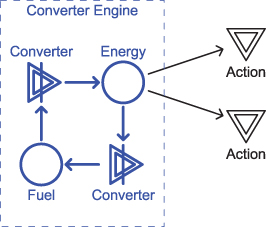
Participants
• Two resources: energy and fuel
• A converter that changes fuel into energy
• A converter that changes energy into fuel
• Actions that consume energy
Collaborations
The converters change energy into fuel and fuel into energy. Normally the player ends up with more energy than he started with.
Consequences
A converter engine introduces the chance of a deadlock. When both resources dry up, the engine stops working. Players run the risk of creating deadlocks themselves if they forget to invest energy to get new fuel. Combine a converter engine with a weak static engine to prevent this from happening.
A converter engine requires more work from the player, especially when the converters need to be operated manually.
As with dynamic engines, a positive feedback loop drives a converter engine. In most cases, this feedback loop needs to be balanced by applying some sort of friction.
Implementation
The number of steps involved in the feedback loop of a converter engine strongly affects how hard it is to make it operate efficiently. More steps increase the difficulty; fewer steps reduce the difficulty. At the same time, more steps offer additional opportunities for tuning or adding to the engine.
With too few steps in the system, the advantages of the converter engine are limited, and you might consider replacing it with a dynamic engine. Too many steps might result in an engine that is cumbersome to operate and/or maintain, especially in a board game in which the different elements of the engine usually cannot be automated.
It is possible to create an unpredictable converter engine by introducing randomness, multiplayer dynamics, or skill into the feedback loop. This complicates the converter engine further and often increases the chance that a deadlock will occur.
Many implementations of the converter engine pattern put a limiter somewhere in the cycle to keep the positive engine under control and to keep the engine from producing too much energy. For example, if the number of fuel resources that can be converted each turn is limited, the maximum rate at which the engine can run is capped. In a Machinations diagram, you can use a gate node to limit the flow of resources. In an automobile, the car’s engine converts fuel into energy, which drives the fuel pump; the fuel pump consumes some of that energy to send more fuel to the engine. This creates a positive feedback loop that is limited by the throttle.
Examples
The 1980s-era space trading computer game Elite features an economy that occasionally acts as a converter engine. In Elite, every planet has its own market, selling and buying various trade goods. Occasionally, players will discover a lucrative trade route where they can buy one trade good at Planet A, sell it at a profit at Planet B, and return with another good that is in high demand on Planet A again (Figure B.4). Sometimes these routes involve three or more planets. Essentially, such a route is converter engine. It is limited by the cargo capacity of the player’s ship, which can be enlarged for a price. Other properties of the player’s ship might also affect the effectiveness of the converter engine: The ship’s “hyperspeed” range and its capabilities (or cost) to survive a voyage through hostile territories all affect the profitability of particular trade routes. Eventually, trade routes become less profitable as the player’s efforts reduce the demand, and thus the price, for certain goods over time (a mechanism that is omitted from the diagram).
Figure B.4. Travel and trade in Elite
The player’s location on Planet A or Planet B activates the converters that implement the trading mechanisms in the center. A few possible ship upgrades are included on the right.
A converter engine is at the heart of Power Grid (Figure B.5), although one of the converters is replaced by a more elaborate structure (see the section “Elaboration and Nesting Patterns” in Chapter 7, “Design Patterns”). The players spend money to buy fuel from a market and use that fuel to generate money in power plants. The fiction of the game is that players generate and sell electricity. However, the game mechanics do not model electricity itself; players simply convert fuel directly into money. Surplus money is invested in more efficient power plants and connecting more cities to the player’s power network. The converter engine is limited: The player can earn money only for every connected city, which effectively caps the money output during a turn. Power Grid also has a weak static engine to prevent deadlocks: The player will collect a small amount of money during a turn even if the player failed to generate money through power plants. The converter engine of Power Grid is slightly unpredictable as players can drive up the price of fuel by stockpiling it, which acts as a stopping mechanism at the same time.
Figure B.5. The production mechanism in Power Grid. The converter engine is in blue.
Related Patterns
• A converter engine is well suited to be combined with the engine building pattern because there are many opportunities to change the settings of the engine: the conversion rate of two converters and possibly the setting of a limiter.
• The positive feedback a converter engine creates is best balanced by introducing some sort of friction.
• A converter engine elaborates the static engine pattern.
• A converter engine can be elaborated by the engine building and the worker placement pattern.
Engine Building
• Type: Engine
• Intent: A significant portion of gameplay is dedicated to building up and tuning an engine to create a steady flow of resources.
• Motivation: A dynamic engine, converter engine, or a combination of different engines form a complex and dynamic core of the game. The game includes at least one, but preferably multiple, mechanics to improve the engine. These mechanics can involve multiple steps. For the engine building pattern to generate interesting gameplay, it should not be trivial for the player to assess the state of the engine.
Applicability
Use engine building when:
• You want to create a game that has a strong focus on building and construction.
• You want to create a game that focuses on long-term strategy and planning.
The structure of the core engine is an example. There is no fixed way of building the engine. Engine building requires only that several building mechanics operate on the engine and that the engine produces energy.
Structure

Participants
• The core engine usually is a complex structure combining multiple engine types.
• At least one, but usually multiple, building mechanisms to improve the core engine.
• Energy is the main resource produced by the core engine.
Collaborations
Building mechanisms increase the output of the engine. If energy is required to activate building mechanisms, then a positive, constructive feedback loop is created.
Consequences
The engine building increases the difficulty of a game. It is best suited to slower-paced games because it involves planning and strategic decisions.
Implementation
Including some form of unpredictability is a good way to increase difficulty, generate varied gameplay, and avoid dominant strategies. Engine building offers many opportunities to create unpredictability because the core engine tends to consist of many mechanisms. The complexity of the core engine itself usually also causes some unpredictability.
When using the engine building pattern with feedback, it is important to make sure the positive, constructive feedback is not too strong and not too fast. In general, you want to spread out the process of engine building over the entire game.
An engine building pattern operates without feedback when energy is not required to activate building mechanisms. This can be a viable structure when the engine produces different types of energy that affect the game differently and allows the players to follow different strategies that favor particular forms of energy above others. However, it usually does require that the activation of building mechanisms is restricted in some way.
The upgrade mechanism in a dynamic engine pattern also is an example of a building mechanism. In fact, the dynamic engine is a simple and common implementation of an engine building pattern. However, its simplicity means that a dynamic engine allows only one or maybe two kinds of upgrades. The typical core engines in a game that follow the engine building pattern allow for many more upgrade options.
Examples
SimCity is a good example of engine building. The energy in SimCity is money, which is used to activate most building mechanisms. The mechanisms consist of preparing building sites, zoning, building infrastructure, constructing special buildings, and demolition. The core engine of SimCity is quite complex with many internal resources such as people, job vacancies, power, transportation capacity, and three different types of zones. Feedback loops within the engine cause all sorts of friction and effectively balance the main positive feedback loop, up to the point that the engine can collapse if the player is not careful and manages the engine poorly.
In the board game Puerto Rico, each player builds up a New World colony. The colony generates different types of resources that can be reinvested or converted into victory points. The core engine includes many elements and resources such as plantations, buildings, colonists, money, and a selection of different crops. Puerto Rico is a multiplayer game in which the players compete for a limited number of positions that allow different actions to improve the engine; they compete for different building mechanics. This way, a strong multiplayer dynamic is created that contributes much of its gameplay.
Related Patterns
• Applying multiple feedback to the building mechanisms is a good way to increase the difficulty of the engine building pattern.
• All friction patterns are suitable to balance the typical positive feedback created by an implementation of engine building that consumes energy to activate building mechanisms.
• The dynamic engine is one of the simplest possible implementations of an engine building pattern.
• The engine building pattern elaborates the dynamic engine and converter engine patterns.
• The engine building pattern can be elaborated by the worker placement pattern.
Static Friction
• Type: Friction
• Intent: A drain automatically consumes resources produced by the player.
• Motivation: The static friction pattern counters a production mechanism by periodically consuming resources. The rate of consumption can be constant or subjected to randomness.
Applicability
Use static friction when:
• You want to create a mechanism that counters production but can eventually be overcome by the players.
• You want to exaggerate the long-term benefits from investing in upgrades for a dynamic engine.
Structure
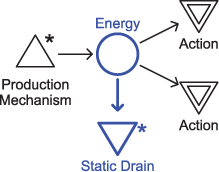
Participants
• A resource: energy
• A static drain that consumes energy
• A production mechanism that produces energy
• Other actions that consume energy
Collaborations
The production mechanism produces energy that players need to use to perform actions. The static drain consumes energy outside players’ direct control.
Consequences
The static friction pattern is a relatively simple way to counter positive feedback created by engine patterns. However, it tends to emphasize the long-term strategy inherent to the dynamic engine because it reduces the initial output of the dynamic engine but does not affect any upgrades.
Implementation
An important consideration when implementing static friction is whether the consumption rate is constant or subject to some sort of randomness. Constant static friction is the easiest to understand and most predictable, whereas random static friction can cause more noise in the dynamic behavior of the game. The latter can be a good alternative to using randomness in the production mechanism. The frequency of the friction is another consideration: When the feedback is applied at short intervals, the overall system will be more stable than when the feedback is applied at long or irregular intervals, which might cause periodic behavior in the system. In general, the effects of a continual loss of energy on the dynamic behavior of the system are less powerful than a periodic loss of the same amount of energy.
Examples
In the Roman city-building game Caesar III, the player must pay tribute to the emperor at particular moments during each mission. The schedule of the tribute payments is fixed for each mission and not affected by the player’s performance. In effect, they cause a very infrequent and high form of static friction that causes a huge tremor in the game’s internal economy. See Chapter 9, “Building Economies,” for a more detailed discussion of this game.
The dynamic engine in Monopoly is countered by different types of friction, including static friction (Figure B.6). The main mechanism that implements static friction is the Chance cards through which the player infrequently loses money. Although some of these cards take into account the player’s property, most of them do not.
Figure B.6. Static friction in Monopoly
You might think that paying rent to other players is also a form of static friction because the frequency and severity of the payments are far beyond the direct control of the player who has to pay. However, paying rent is an example of the attrition pattern, not static friction. The rate of the friction does change over time, and players have some indirect effect on it: When a player is doing well, chances are that his opponents are not, which negatively affects this friction. The diagram in Figure B.8 does not include this aspect because it is made from the viewpoint of an individual player.
Related Patterns
• Static friction exaggerates long-term investments, and therefore it is best suited to be used in combination with a static engine, converter engine, or an engine building pattern.
• Static friction is elaborated by the dynamic friction or the slow cycle pattern.
Dynamic Friction
• Type: Friction
• Intent: A drain automatically consumes resources produced by the player; the consumption rate is affected by the state of other elements in the game.
• Motivation: Dynamic friction counteracts production but adapts to the performance of the player. Dynamic friction is a classic application of negative feedback in a game.
Applicability
Use dynamic friction when:
• You want to balance games in which resources are produced too fast.
• You want to create a mechanism that counters production and automatically scales with players’ progress or power.
• You want to reduce the effectiveness of long-term strategies created by a dynamic engine in favor of short-term strategies.
Structure

Participants
• A resource: energy
• A dynamic drain that consumes energy
• A production mechanism that produces energy
• Other actions that consume energy
Collaborations
The production mechanism produces energy that players need to perform actions. The dynamic drain consumes energy outside players’ direct control but is affected by the state of at least one other element in the game system.
Consequences
Dynamic friction is a good way to counter positive feedback created by engine patterns. Dynamic friction adds a negative feedback loop to the game system.
Implementation
There are several ways of implementing dynamic feedback. An important consideration is the choice of the element that causes the consumption rate to change. In general, this can be either the amount of available energy itself, the number of upgrades to a dynamic engine or a converter engine, or the player’s progress toward a goal. When the amount of available energy changes the friction, the negative feedback tends to be fast. When progress or production power is the cause, the feedback is more indirect and probably slower.
When dynamic friction is used to counter a positive feedback loop, it is important to consider the difference in characteristics of the positive feedback loop and the negative feedback loop implemented through the dynamic friction. When the characteristics are similar (equally fast, equally durable, and so on), the effect is far more stable than when the differences are large. For example, when a slow and durable dynamic friction is acting against a fast but nondurable positive feedback that initially yields a good return, players will initially make a lot of progress but might suffer in the long run. Fast positive feedback and slow negative feedback seems to be the most frequently encountered combination.
Examples
The mechanics of tower defense games typically revolve around a dynamic drain on the player’s life points caused by enemies that the player must keep under control by building towers (Figure B.7). In this case, the goal of the game is to prevent dynamic friction from taking effect. In real tower defense games, placing the right types of towers involves a strategy that is omitted from this diagram.
Figure B.7. Dynamic friction in tower defense games
Dynamic friction is used in the city production mechanism in Civilization (Figure B.8). In this game, the player builds cities to produce food, shields, and trade. As cities grow, they need more and more food for their own population. Players have some control over how much food is produced compared with other resources, but the players’ options are limited by the surrounding terrain. By choosing to produce a lot of food early, cities initially produce fewer other resources but grow faster because of great potential. Fast growth creates a problem, however, because the happiness rating of a city must stay equal to or higher than half the population, or else the production stops due to of civil unrest. Initially, a city has a happiness value of two. Players can create more happiness by building special buildings or by converting trade into culture. Both approaches cause more dynamic friction with different profiles on the production process. Constructing special buildings is slow and requires a high investment but is highly durable and has a relatively high rate of return. Converting trade to culture is fast but has a relatively low return for the investment required.
Figure B.8. The city economy of Civilization. Dynamic friction mechanisms are printed in color. The player can freely adjust the culture and research settings to control unrest and research production. These settings are global and affect all cities equally.
Related Patterns
• Dynamic friction is a good way to balance any pattern that causes positive feedback and often is part of the multiple feedback pattern.
• Attrition elaborates dynamic friction that is the result of multiplayer interaction.
• Dynamic friction is elaborated by a stopping mechanism.
Stopping Mechanism
• Type: Friction
• Intent: Reduce the effectiveness of a mechanism every time it is activated.
• Also known as: Law of diminishing returns.
• Motivation: To prevent a player from abusing a powerful mechanism, the mechanism’s effectiveness is reduced every time it is used. In some cases, the stopping mechanism is permanent, but usually it’s not.
Applicability
Use a stopping mechanism when:
• You want to prevent players from abusing particular actions.
• You want to counter dominant strategies.
• You want to reduce the effectiveness of a positive feedback mechanism.
Structure
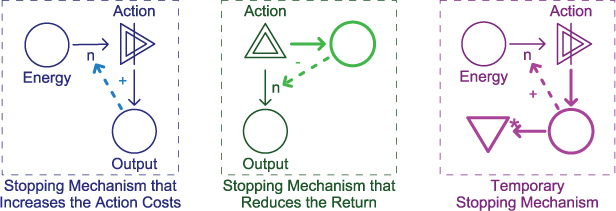
Participants
• An action that might produce some sort of output
• A resource energy that is required for the action
• The stopping mechanism that increases the energy cost or reduces the output of the action
Collaborations
For a stopping mechanism to work, the action must have an energy cost, produce resources, or both. The stopping mechanism reduces the effectiveness of an action mechanism every time it is activated by increasing the energy costs or reducing the output of resources.
Consequences
Using a stopping mechanism can reduce the effect of a positive feedback loop considerably and even make its return insufficient.
Implementation
When implementing a stopping mechanism, it is important to consider whether to make the effects permanent. When the accumulated output is used to measure the strength of the stopping mechanism, the effects are not permanent. In that case, it requires players to alternate frequently between creating the output and using the output in other actions.
A stopping mechanism can apply to each player individually or can affect multiple players equally. In the latter case, the game will reward players that use the action before other players do. This means that the stopping mechanism can create a form of feedback depending on whether leading or trailing players are likely to act first.
Examples
A subtle stopping mechanism can be found in the timber-harvesting mechanism in Warcraft III. In Warcraft III, players can assign peasants to cut wood and produce lumber. Because the peasants have to transport the lumber back from the forest to the player’s base and cannot cut wood while transporting, the distance to the forest has an effect on effectiveness of the production mechanism. Because cutting wood clears the forest, the distance increases as the player cuts more and more wood. Figure B.9 represents these mechanics.
Figure B.9. The stopping mechanism in Warcraft III: The production rate for each peasant will drop to 0.4 when the forest is almost cleared.
The price mechanism of the fuel market in Power Grid involves a stopping mechanism (Figure B.10). In Power Grid, players use money to buy fuel and burn fuel to generate money. This positive feedback loop is counteracted by the fact that buying a lot of fuel actually drives up the price for all players. Because the leading player acts last in Power Grid, this stopping mechanism causes powerful negative feedback for the leading player.
Figure B.10. The stopping mechanism in Power Grid drives up the price of fuel and causes negative feedback, especially for leading players.
Related Patterns
• Stopping mechanisms are often found in systems that implement multiple feedback.
• A stopping mechanism elaborates the dynamic friction pattern.
• A stopping mechanism might be elaborated by a slow cycle pattern.
Attrition
• Type: Friction
• Intent: Players actively steal or destroy resources of other players that they need for other actions in the game.
• Motivation: By allowing players to directly steal or destroy each other’s resources, players can eliminate each other in a struggle for dominance.
Applicability
Use attrition when:
• You want to allow direct and strategic interaction between multiple players.
• You want to introduce feedback into a system whose nature is determined by the strategic preferences and/or whims of the players.
Structure

Participants
• Multiple players who have the same (or similar) mechanics and options.
• A strength resource. A player who loses all his strength is eliminated from the game.
• A special attack action that drains or steals the other player’s strength.
Collaborations
By performing attack actions, players can drain each other’s strength. Attacking may, or may not, cost strength to perform. If attacking doesn’t cost strength, it should require time to perform or involve some measure of skill or randomness. The balance between the attack costs, its effectiveness, and how beneficial the other actions in the game are determine the effectiveness of the attack and the dominance of the attrition pattern.
Remember that the terms constructive and destructive describing feedback are not the same as positive and negative. See the section “Seven Feedback Characteristics” in Chapter 6, “Common Mechanisms,” for an explanation of the distinction.
Consequences
Attrition introduces a lot of dynamism into a system because players directly control the measure of the destructive force applied to each other. Often, this introduces destructive feedback because the current state of a player will cause reactions by other players. Depending on the nature of the winning conditions and the current state of the game, this feedback might be negative when it stimulates players to act and conspire against the leader, but it also might cause positive feedback when players are stimulated to attack and eliminate weaker players.
Implementation
For attrition to work well, players should be required to invest some sort of resource in attacking that could also be spent otherwise. If they don’t have to make this investment, in a two-player game attrition simply becomes a race to destroy the opponent with few or no strategic choices. In a multiplayer game that facilitates social interaction between the players, attacking without investment works a little better because the players need to choose whom to attack.
It is quite common to implement attrition using two resources, life and energy, instead of just one, strength. Players use energy to perform actions and lose the game when they run out of life. When using these two resources, it is important that they be somehow related. Often, players are allowed to spend energy to gain more life. Sometimes the relationship between life and energy is implicit. For example, when a player must choose between spending energy or gaining life, there is an implicit link between the two because players generally cannot do both at the same time.
In a two-player version of attrition, the game must include other actions, and games for more than two players often allow other actions that the players can perform. Most of the time these actions constitute some sort of production mechanism for strength, which increases the effectiveness the players’ defensive or offensive capabilities (and thus elaborates the attrition pattern to an arms race pattern). Most real-time strategy games include all these options, often with multiple variants for each.
The winning conditions and effects of eliminating another player have a big impact on the attrition pattern. The winning condition does not need to be elimination, however. Players might score points, or reach a particular goal outside the attrition pattern, which automatically widens the number of strategies available. When there is a bonus for attacking or eliminating players, the pattern can be made to stimulate the elimination of weaker players.
Examples
The trading card game Magic: The Gathering implements an elaborate version of the attrition pattern. Figure B.11 presents this implementation, although it shows the details from the perspective of a single player only.
Figure B.11. The attrition mechanism in Magic: The Gathering
In Magic: The Gathering, players can play one card every turn. These cards allow players to add lands, summon creatures, cast spells to heal, or deal direct damage to their opponent or their opponent’s creatures. But all actions except playing lands cost mana (magical energy). The more mana players have, the more they can spend each turn and the more powerful actions they can play. Creatures will fight other creatures, and when there are no more enemy creatures, they will damage the opponent directly. Players who lose all their life points are eliminated from the game. Magic: The Gathering is an example of a game that implements attrition using separate resources for life and energy (or in this case, life and mana).
The different gameplay options in Magic: The Gathering illustrate how attrition can work differently. Direct damage briefly triggers a drain. As its name implies, it is fast and direct. On the other hand, summoning creatures activates a permanent drain on the opponent’s creatures and life. The effects usually are not as powerful as direct damage, but because they accumulate over time, they can be quite devastating. The cards in the player’s hand determine which options are available to him and exactly how powerful those options are. Because players build their own decks from a large collection of cards, deck building is an important aspect of Magic: The Gathering.
The most obvious way to implement attrition is in a symmetrical game. However, many single-player games and even certain types of multiplayer games use asymmetrical attrition. An example of asymmetrical attrition can be found in the board game Space Hulk in which one player, controlling a handful of space marines, tries to accomplish a mission while the other player, controlling an unlimited supply of alien “genestealers,” tries to prevent that. The genestealer player tries to reduce the number of space marines to stop them from accomplishing their goals and wins when the genestealers have destroyed enough space marines. The space marine player usually cannot win by destroying genestealers but must keep the number of genestealers under control to survive, because the genestealers become more effective as their numbers grow. Figure B.12 is a rough illustration of the mechanics in Space Hulk.
Figure B.12. Asymmetrical attrition in Space Hulk
Related Patterns
• Attrition works well with any sort of engine pattern. Trade can be used as an alternative form of multiplayer feedback that is constructive instead of destructive and is nearly always negative.
• Attrition elaborates the dynamic friction pattern.
• Attrition can be elaborated by the arms race and worker placement patterns.
Escalating Challenge
• Type: Escalation
• Intent: Progress toward a goal increases the difficulty of further progression.
• Motivation: A positive feedback loop between player progress and the game’s difficulty makes the game increasingly harder for players as they get closer to achieving their goals. This way, the game quickly adapts to the player’s skill level, especially when the good performance allows the player to progress more quickly.
Applicability
Use escalating challenge when:
• You want to create a fast-paced game based on player skill (usually physical skill) in which the game gets harder as the player advances; his ability to complete tasks is inhibited as he goes.
• You want to create emergent mechanics that (partially) replace predesigned level progression.
Structure
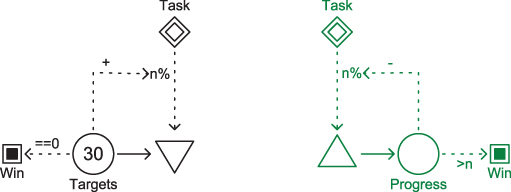
Participants
• Targets represent unresolved tasks.
• Progress represents the player’s progress toward a goal.
• A task either reduces the number of targets or produces progress.
• A feedback mechanism makes the game more difficult as the player progresses toward the goal or reduces the number of targets.
Collaborations
The task reduces targets, produces progress, or does both. The feedback mechanic increases the difficulty of the task as the player gets closer to achieving the goal.
Consequences
Escalating challenge is based on a simple positive feedback loop affecting the difficulty of the game. Its mechanism quickly adjusts the difficulty of the game to the skill level of the player. If failure at the task ends the game, escalating challenge ensures a very quick game.
Implementation
The task in a game that implements the escalating challenge pattern is typically affected by player skill, especially when the escalating challenge pattern makes up the most of the game’s core mechanics. When the task is a random or deterministic mechanic, players will have no control over the game’s progress. Only when the escalating challenge pattern is part of a more complex game system and players have some sort of indirect control over the chance of success does a random or deterministic mechanic become viable. Using multiplayer dynamic mechanisms is an option but probably works better in a more complex game system as well.
Examples
Space Invaders is a classic example of the escalating challenge pattern. In Space Invaders, the player needs to destroy all the invading aliens before they can reach the bottom of the screen. Every time the player destroys an alien, all other aliens speed up a little, making it more difficult for the player to shoot them.
Pac-Man is another example. In Pac-Man, the task is to eat all the dots in a level, while the chasing ghosts make it more and more difficult to get to the last remaining dots (see Chapter 5, “Machinations,” for a detailed discussion and diagram of Pac-Man).
Related Patterns
By combining escalating challenge with static friction or dynamic friction, a game can be created that quickly matches its difficulty to the ability of the player.
Escalating Complexity
• Type: Escalation
• Intent: Players act against growing complexity, trying to keep the game under control until positive feedback grows too strong and the accumulated complexity makes them lose.
• Motivation: Players are tasked to perform an action that grows more complex if the players fail and in which complexity contributes to the difficulty of the task. As long as players can keep up with the game, they can keep on playing, but once the positive feedback spins out of control, the game ends quickly. As the game progresses, the mechanism that creates the complexity speeds up, ensuring that at some point players can no longer keep up and eventually must lose the game.
Applicability
Use escalating complexity when:
• You aim for a high-pressure, skill-based game.
• You want to create emergent mechanics that (partially) replace predesigned level progression.
Structure
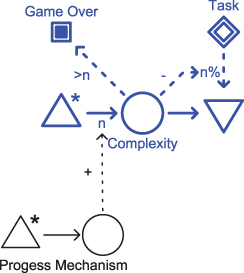
Participants
• The game produces complexity that must be kept under a certain limit by the player.
• A task performed by the player reduces complexity.
• A progress mechanism increases the production of complexity over time.
Collaborations
Complexity immediately increases the production of more complexity, creating a strong positive feedback loop that must be kept under control. The player loses when complexity exceeds his ability to manage it.
Consequences
Given enough skill, players can keep up with the increase in complexity for a long time, but when players no longer keep up, complexity spins out of control and the game ends quickly.
Implementation
The task in a game that implements the escalating complexity pattern is typically affected by player skill, especially when escalating complexity makes up most of the game’s core mechanics. When the task is governed by a random or deterministic mechanism, players will have no control over the game’s progress. Random or deterministic mechanics work a little better in more complex game systems in which players have some control over their chance of success. Using a multiplayer task is an option, but it probably also works better in a more complex game system.
Randomness in the production of complexity creates a game with a varied pace, where players might struggle to keep up with production at its peak but get a chance to catch their breath when complexity production slows down a little.
There are many ways to implement the progress mechanic, from a simple time-based increase of the production of complexity (as is the case in the previous sample structure) to complicated constructions that rely on other actions by the player or by other players. This way, it is possible to combine escalating complexity with escalating challenge by introducing positive feedback to the progress mechanic as a result of the execution of the task.
Escalating complexity lends itself well to serve as part of a multiple feedback structure in which the complexity feeds into several feedback loops with different signatures. For example, escalating complexity can be partially balanced by having the task feed into a much slower negative feedback loop governing the production of complexity.
Examples
In Tetris, a steady flow of falling tetrominoes produces complexity. There is a slight randomness in this production as the different types of tetrominoes are created over time. Players need to place the tetrominoes in such a way that they fit together closely. When a line is completely filled, it disappears, making room for new tetrominoes. When players fail to keep up, the tetrominoes pile up quickly, and they will have less time to place subsequent tetrominoes. This can quickly increase the complexity of the field when players are not careful and cause them to lose the game if the pile of tetrominoes reaches the top of the screen. In Tetris, levels create the progression mechanism. Every time the player clears ten lines, the game advances to the next level and the tetrominoes start falling faster, making it more and more difficult to place them accurately. In this case, the level mechanism is also an example of the escalating challenge pattern.
Figure B.13 represents these mechanics of Tetris. In this diagram, tetrominoes are converted into points. The number of points goes up when there are more tetrominoes in the game. This represents the possibility to clear more lines at once and enables a high-risk, high-reward strategy. The chart in Figure B.13 clearly shows that once the pace grows too great for the player to keep up, the game rapidly spins out of control.
Figure B.13. Escalating complexity in Tetris
In the independently developed action shooter Super Crate Box, players are required to pick up crates containing different weapons, while keeping the number of enemies under control by shooting them. As soon as the player touches an enemy, he is killed. Enemies spawn at the top of the screen and run down the level to disappear at the bottom. An enemy that makes it to the bottom respawns at the top of the screen but moves much faster the second time. The player carries only one weapon at a time, and not all weapons are equally powerful. However, because the only way to get ahead is to pick up crates and change weapons, the player is forced to make the best use of whatever he picks up. The player has to alternate between killing enemies to keep their numbers under control and picking up boxes to score more points. Figure B.14 represents a diagram for Super Crate Box.
Figure B.14. Super Crate Box has the players alternate between scoring points and keeping enemy numbers under control.
Related Patterns
• Any type of engine pattern can be used to implement the progress mechanism.
• It is common to find the progression mechanism implemented as an escalating challenge pattern.
Arms Race
• Type: Escalation
• Intent: Players can invest resources to improve their offensive and defensive capabilities against other players.
• Motivation: Allowing players to invest in their offensive and defensive capabilities introduces many strategic options into the game. The player can choose strategies that fit his skills and preferences.
Applicability
Use arms race when:
• You want to create more strategic options or avoid dominant strategies in games that use the attrition pattern.
• You want to lengthen the playing time of your game.
• You want to encourage players to develop strategies and playing styles that suit their individual skills and preferences.
Structure
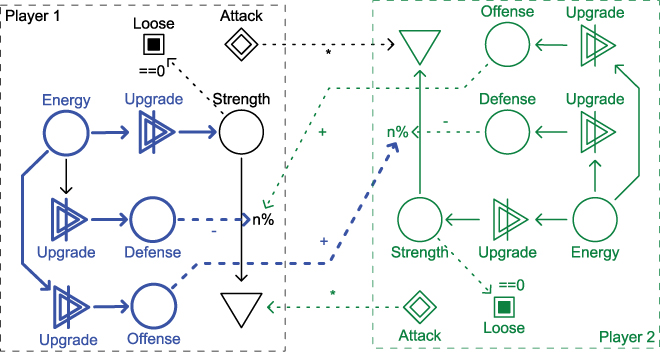
Participants
• Multiple players that can activate the same (or similar) attack mechanisms.
• A strength resource. A player that loses all his strength is eliminated from the game.
• An optional energy resource that is consumed by upgrades. In some cases, energy and strength are the same.
• At least one upgrade mechanisms to improve the offensive or defensive capabilities of each player.
Collaborations
The attack mechanisms allow players to drain or steal each other’s strength. Activating the attack and upgrade mechanisms require the player to invest energy or time. The upgrade mechanisms improve the player’s offensive or defensive capabilities or restore the player’s strength.
Consequences
Arms race introduces many strategic options for players to explore, which can make the game difficult to balance. In general, it is best to implement an intransitive (rock-paper-scissors) mechanism in the upgrade options so that every strategy has a counter-strategy. For example in many medieval war games, heavy infantry beats cavalry, while cavalry beats artillery, and artillery beats infantry. In this case, the best strategy and most effective army composition is partially determined by the choices made by your opponent.
Many strategic options allow players to develop their own playing styles and strategies. For example, if a player likes a particular mechanism, she can use it more often, while if she dislikes a mechanism, she might ignore it.
Using an arms race pattern typically lengthens a game, because players always have the option to play defensively at first. This can even delay confrontation and conflict for a long time.
Implementation
What resources are required to pay for upgrades is an important design decision when implementing an arms race. When strength and energy are the same, the player might over-invest and make himself vulnerable, especially if the upgrades take time to take effect. When energy is separate from strength, you need to consider carefully what the relationship between strength and energy actually is. Strength might determine the production rate of energy. This would create a strong positive, destructive feedback loop. Energy might also be converted into strength, or energy might be invested to produce strength over time. There are many options.
A good way to prevent an arms race from lengthening the game too much is to make the resource to activate upgrades heavily contested, either because all players are trying to harvest the same resources or because upgrades require the player to invest strength.
An arms race doesn’t have to be symmetrical. It is possible to create an arms race with two different sides, although this would be more difficult to balance.
Examples
Many real-time strategy games implement the arms race pattern. For example, StarCraft II and Warcraft III allow the player to investigate technology to improve the fighting capabilities of his units. In these games, strength is measured as the sum of the player’s units and buildings, whereas energy is harvested by worker units and is used to upgrade and build new units.
An arms race is also often found in tower defense games, although in those games it is an asymmetrical implementation of the pattern. For example, the green and blue mechanisms in Figure B.15 represent two different mechanisms that increase the offensive capacities of the player (blue) and the enemies (green). In most tower defense games, there are many more upgrade mechanisms: Players can upgrade towers or choose between different towers for different effects, while the enemy waves will include other types of enemies that require a different type of response by the player.
Figure B.15. An asymmetrical arms race in a tower defense game
Related Patterns
• Arms race combines well with a dynamic engine to produce energy and strength. This combination is found in many real-time strategy games.
• Arms race elaborates the attrition pattern.
• Arms race can be elaborated by the worker placement pattern.
Playing Style Reinforcement
• Type: Miscellaneous
• Intent: By applying slow, positive, constructive feedback on player actions, the game encourages specialization and gradually adapts to the player’s preferred playing style.
• Also Known As: Role-playing game (RPG) elements.
• Motivation: Slow, positive, constructive feedback on player actions (actions that have another effect on the game) causes the player’s avatar or units to develop over time. As the actions themselves feed back into this mechanism, the avatar or units specialize over time, getting better at performing a particular task. As long as there are multiple viable strategies and specializations, the avatar and the units will, in time, reflect the player’s preferences and style.
Applicability
Use playing style reinforcement when:
• You want players to make a long-term investment in the game that spans multiple play sessions.
• You want to reward players for building, planning ahead, and developing personal strategies.
• You want players to grow into a specific role or strategy.
Structure
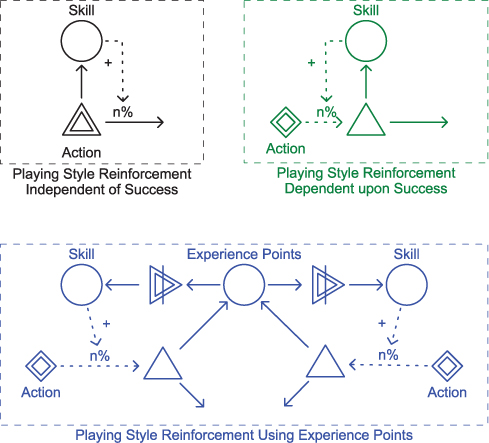
Participants
• Actions players can perform whose success depends in part on the attributes of the player’s character or the units involved in the action.
• A resource ability that affects the chance that actions succeed and that can grow over time.
• An optional resource experience points that can be used to increase an ability. Some games call these skill points and include a different resource called experience points that cannot be traded.
Collaborations
• Ability affects the success rate of actions.
• Attempting actions generates experience points or directly improves abilities. Some games require the action to be successful, while others do not.
• Experience points might be spent to improve abilities.
Consequences
Playing style reinforcement works best in games that are played over multiple sessions and over a long time.
Playing style reinforcement works well only when multiple strategies and play styles are viable options in the game. When there is only one, or only a few, all the players will use the same strategy, which makes the game uninteresting.
Playing style reinforcement can inspire min-maxing behavior with players. This refers to a strategy in which players seek the best possible options that will allow them to gain powerful avatars or units as fast as possible. If min-maxing is successful, it usually becomes a dominant strategy. This can happen when the strength of the feedback is not distributed evenly over all actions and strategies.
Playing style reinforcement favors experienced players over inexperienced players, because the experienced ones will have a better understanding of their options and the long-term consequences of their actions.
Playing style reinforcement rewards the player who can invest the most time in playing the game. In this case, time spent playing can compensate for different levels of skill among players, which can be a wanted or an unwanted side-effect.
It can be ineffective for a player to change strategies over time in a game with playing style reinforcement, because the player will lose the benefit of previous investments in another play style.
Implementation
Whether or not to use experience points is an important decision when implementing play style reinforcement. When using experience points, there is no direct coupling between growth and action, allowing the player to harvest experience with one strategy to develop the skills to excel in another strategy. On the other hand, if you do not use experience points, you have to make sure that the feedback is balanced for the frequency of the actions; actions that are performed more often should have weaker feedback than actions that can be practiced infrequently.
Role-playing games are the quintessential example of games built around the play style reinforcement pattern. In these games, the feedback loops are generally quite slow and balanced by an escalating challenge, dynamic friction, or a stopping mechanism to make sure avatars do not progress too fast. In fact, most of these games are balanced in such a way that progression is initially fast and gradually slows down, usually because the required investment of experience points increases exponentially.
You must also decide whether the action needs to be executed successfully to generate the feedback. How you decide this issue can dramatically affect player behavior. When success is required, the feedback loop gains influence. In that case, it is probably best to have the difficulty of the player’s tasks also affect the success of an action and to challenge the player with tasks of varying difficulty levels, thus allowing them to train their avatars. When success is not required to earn experience points, players have more options to improve neglected abilities during later and more difficult stages. However, it might also encourage players to perform a particular action at every conceivable opportunity, which could lead to some unintended, unrealistic, or comic results, especially when the action involves little risk.
Examples
Many pen-and-paper role-playing games implement playing-style reinforcement. For example, in Warhammer Fantasy Role-Play and Vampire: The Masquerade, players are awarded experience points for achieving goals in the game. They can spend experience points on improving their character’s abilities. Curiously, the original role-playing game Dungeons & Dragons doesn’t have playing-style reinforcement. In Dungeons & Dragons, players are awarded experience points that they need to accumulate to advance to the next level. However, the player has no influence over how her character’s abilities improve when she levels up; the character’s abilities do not adapt to the playing style or preferences of the player.
In the computer role-playing game The Elder Scrolls IV: Oblivion, the avatar’s progress is directly tied to her actions. The avatar’s ability corresponds directly to the number of times she has performed the associated actions. Oblivion implements playing-style reinforcement without experience points.
In Civilization III, there are different ways in which a player can win the game. A player reinforces his chosen strategy of military, economic, cultural, or scientific dominance (or any combination) by building city improvements and wonders of the world that favor that strategy. In Civilization III, several resources take the role of experience points; money and production are prominent examples. These resources are not necessarily tied to one particular strategy in the game. Money generated by one city can be spent to improve production in another city in the game.
Related Patterns
When playing style reinforcement depends on the success of actions, it creates a powerful feedback. In that case, a stopping mechanism is often used to increase the price of new upgrades to an ability.
Multiple Feedback
A full description of the multiple feedback pattern is included in the online version of Appendix B, which you can find at www.peachpit.com/gamemechanics.
Trade
A full description of the trade pattern is included in the online version of Appendix B, which you can find at www.peachpit.com/gamemechanics.
Worker Placement
A full description of the worker placement pattern is included in the online version of Appendix B, which you can find at www.peachpit.com/gamemechanics.
Slow Cycle
A full description of the slow cycle pattern is included in the online version of Appendix B, which you can find at www.peachpit.com/gamemechanics.


